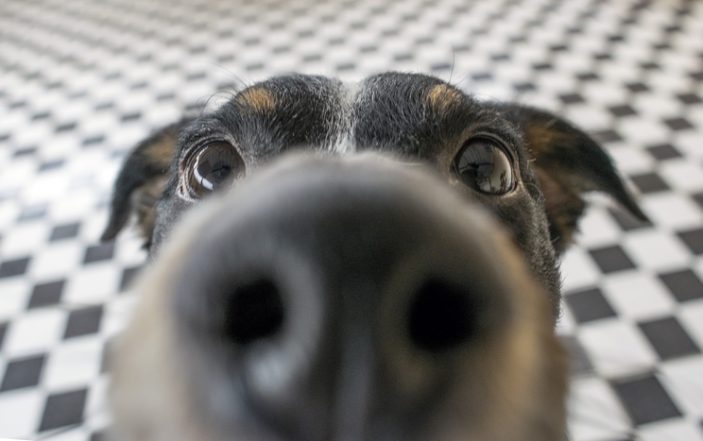Scent Dogs Detecting COVID-19
https://bmcinfectdis.biomedcentral.com/articles/10.1186/s12879-020-05281-3
I had to read this paper three times to make sure this wasn’t a joke. Scent dogs identify COVID-19 with a sensitivity of 82.6% and specificity of 96.4%. This is even better than the current SARS-CoV-2 tests we have now. Two thoughts come to mind after reading this trial: 1) Did anyone worry about the dogs getting infected and spreading the illness? 2) If the scent detection doesn’t work, at least we have built in therapy dogs.
—– Salim R. Rezaie, MD
Why not? The dogs are at least as good as our currently not so good tests. The recent positive then negative tests for the Governor of Ohio don’t exactly exude confidence in our current testing. On the plus side, who wouldn’t trade a nasal swab for a sniff from a dog?
–Andrew Kalnow, DO
Agree with Drew and Sal and have a few additional questions: what is the gold standard — dog sniff or nasopharyngeal deep brain biopsy? What orifice are they actually sniffing? Can they detect asymptomatic patients? Are therapy dogs protective?
–– E. Paul DeKoning, MD, MS, FACEP, FAAEM
I love it. Send in the dog. And I don’t have to wait for the test to return. Now put them in airports and take off the masks. I think you need to go nose to nose with one of these dogs before every shift. Besides being a good screener, it would put me in a better mood.
–Mark Plaster, MD, JD
Come on. What patient wouldn’t love a coronapup? Think like an entrepreneur here, folks. Trained dogs have a sensitivity of 82% and a specificity of 96% in detecting Coronavirus, which is better than any rapid test we can come up with. Patients are happy, we get immediate results and there’s no damage to the cribiform plate. What’s not to love? So what if the dogs have to bury their nose in an inconvenient place? The biggest question for me would be how much Medicare reimburses for the testing.
– William Sullivan, DO, JD
Lawsuit of Nursing Home Due to COVID-19 Death
This seems like a loser of a lawsuit to me. The plaintiff would have to prove that the alleged “negligence” caused the patient to get COVID (as opposed to the patient contracting COVID from any other symptomatic or asymptomatic COVID carrier), that avoiding the negligent acts would have prevented the patient from contracting COVID, and that the resident actually died from COVID. Then there’s immunity from liability for many COVID-related issues under many state executive orders and under the federal PREP Act. If this case proceeds, look for a flood of similar litigation in Tennessee.
– William Sullivan, DO, JD
I’m with Bill on this one. It will never fly as a real suit. But that doesn’t mean that the insurance companies won’t settle for the nuisance value. I agree also that if a few of these succeed they will flood the courts and TV advertisements.
–Mark Plaster, MD, JD
This has to be a huge concern for any nursing home facility. Elderly population in closed quarters equals COVID-19 disaster. This however is not a new problem. Nursing homes have long struggled with infection control. The difference is now with lockdowns, residents don’t have people to advocate for their safety, in-depth inspections have been halted, and ultimately transparency has vanished. I don’t think this is gross negligence as much as shining a light on a far bigger problem…shortages of PPE and lacking enough tests to screen residents.
—– Salim R. Rezaie, MD
What about the facilities that were not permitted (under what penalty, I wonder?) to refuse COVID patient admissions to their facility? New York and Michigan come to mind. Where is the justice for those patients and families?
–– E. Paul DeKoning, MD, MS, FACEP, FAAEM
Towns without Doctors
https://www.buckscountycouriertimes.com/news/20200805/covid-creeping-into-towns-without-doctors
Sounds like a great opportunity for telemedicine, which is rightly gaining steam. It isn’t the solution to everything, but certainly can help. We even used it internally to preserve PPE early on in the pandemic. We hard-wired rooms in our ED and used telehealth to communicate with patients where appropriate to limit the use of PPE, which effectively enabled initial assessment of risk, screening exam, as well as enabled ongoing communication with providers when they (nurses and MDs) needed to remain at the bedside. Doesn’t solve all the problems for rural America (where I live, practice and train residents), but I think we’ll see the potential benefits and uses continue to increase.
–– E. Paul DeKoning, MD, MS, FACEP, FAAEM
Lots of focus with COVID overrunning health systems has focused on metropolitan areas, but the problem is real and possibly more perilous for small towns with little to no medical resources. Small healthcare facilities with few beds can be so easily overrun with just one family becoming sick with an infectious disease. It’s hard for me to fathom working at a facility with less total beds than my entire ED and that being it for a large catchment area. This is just one article of many describing a dire situation not just of personnel shortages, but equipment and space issues leading to true rationing of care.
–Andrew Kalnow, DO
This article struck me for two reasons. First, it shows how fragile the system of medical care is in rural communities. Only five of 67 counties in Pennsylvania have an adequate supply of primary care physicians? That’s a lot scarier than COVID infections to me. Second, what emergency physicians are making the salaries that this article quotes? If those are accurate salaries, I’m heading out East.
– William Sullivan, DO, JD
ER docs in rural settings are the real deal since they seldom have much back up. The case loads aren’t heavy most of the time, but you get it all. I’ve always encouraged my colleagues to look at rural settings. This is just one more reason to consider it.
–Mark Plaster, MD, JD









